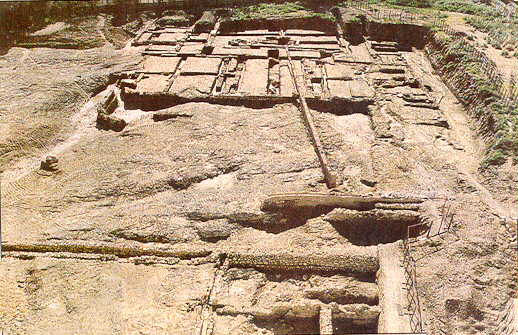
Issue A972 of 1 Oct. 1997
Neolithic Gold Treasure Confiscated in hands of Illicit Dealers
Few of the 54 confiscated items |
Fifty-four ring-idol pendants belonging to the period between 4500 and 3200 BCE were confiscated by the Greek police on 29 September 1997 when the two illicit dealers bargained with a buyer, who was actually an undercover policeman. The Director of the National Archaeological Museum in Athens Dr Aik. Demakopoulou, who examined and dated the gold treasure, believes that the ring-shaped artifacts have to come from an illegal excavation somewhere in Greece and most probably from a neolithic cemetery on one of the Aegean islands.
Archaeologists have unearthed a great number of similarly shaped artifacts in Greece but fewer than ten made of gold, which makes this treasure extremely important from an archaeological point of view. Similar pendants have been unearthed from the cemeteries of the Black Sea and the 2.000 pieces of Varna in Bulgaria are well known. It is assumed that they were wore round the neck to protect the person from evil spirits. The biggest one of the newly confiscated set measures 15,5 cm (height), has a diameter of 12 cm and weighs 80 grams. The whole treasure will be soon on display in the National Archaeological Musuem in Athens, Greece.
Aristotle's Lykeion found in Athens?
Archaeologists believe that the foundations of buildings brought to light a few meters away from the Athens Hilton Hotel have to be the Lykeion (Lyceum) of Aristotle. The location of the building has been roughly known from ancient sources but no major excavations had taken place in the area between Syntagma Sq. and the Athens Hilton Hotel. Construction works for the building of a Museum of Modern Art behind the Byzantine Museum uncovered the site. The site will be thoroughly examined in the years to come and archaeologists will eventually announce whether the site is the lost Lykeion or not.
 Will we discover Pericles grave?
Will we discover Pericles grave?
A new block of flats was going to be built in a lot in Salaminos Street, a few meters away from Kerameikos (the Ancient Athenian Cemetery). Archaeologists had known that the main road leading to the cemetery was the Demosion Sema, a special cemetery for prominent Athenians after the mid 5th c. BCE. On both sides of that road one could see the grave stones of the deceased. Pausanias (1.29) who visited the area in the 2nd c. CE described Demosion Sema in detail. He saw the graves of Pericles, Konon, Cleisthenis etc. In that area of the Demosion Sema, close to the Kerameikos cemetery Pericles delivered to the Athenians his Funeral Oration described in Thucydides. Archaeologists had known that the Demosion Sema was located in the area of Salaminos Street but the area was part of the modern city of Athens with a lot of old buildings and therefore no excavations could have been conducted so far. Now the government is determined to extend excavations in the area, especially where other old and usually not used houses are located.
Early Helladic site in the sea
During the 1997 summer excavation, archaeologists of the Underwater Division of the Greek Archaeological Service discovered in the are of Ermioni, Argolis (Peloponnese) an Early Helladic neolithic site. The village is just 4 m. under the surface of the sea, some of its walls are well preserved and the ceramic fragments found can be dated to c. 2700 BCE. The discovery is also important because it is located just 3 klm north of the well known Franchthi Cave.
Minoan or Aegean style frescoes of c. 1560 BCE in Egypt
SOURCE: Newspaper TA NEA, 5 September 1997, p. 3, Panorama section.
Austrian archaeologists have been excavating a fortress-palace building near Tell El Daba (ancient Avaris) on the Delta of the Nile river in Egypt since 1991. They have collected so far about 400 boxes with pieces from minoan style frescoes. The wall paintings were made c. 1560 BCE with the minoan fresco technique and not the egyptian method of painting a dry wall. Chief excavator Prof. Manfred Bitack showed the findings to minoan fresco specialists Dr. Nano Marinatos and architect Klaire Palyvou, who testified that they are aegean at least in style. There are a lot of unanswered questions though like why were they painted, were they painted by minoan artists or egyptians trained on Crete and what was, after all, the extent of the relations of the minoans with the other peoples of East Mediterranean.
Klaire Palyvou's reconstruction of a 1.20 m fresco |
 Back to Cover
Back to Cover
This page hosted by
 Get your own Free Home Page
Get your own Free Home Page



